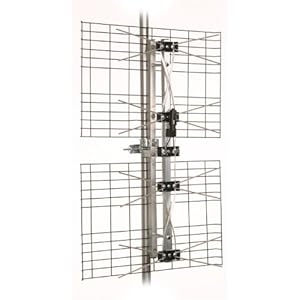We are looking to cut the cable soon, and to do this, we are going to antenna. We live more or less 40 miles form the transmitters, which are in the direction/strength shown: http://www.tvfool.com/?option=com_wrapper&Itemid=29&q=id=0559dba4ea7bbb
We installed two antennas from Antennas Direct (the DB8 and the ClearStream 5) inside the attic with the ClearStream 5 at about 23 feet above the ground, and the DB8 about 20 feet above the ground. We are able to receive channels decently with a 10dB amplifier, except for 8.1 from Indianapolis. 18.1 has many of the same prime time shows, but not the same sports games all the time. We got 18.1 to work with an aluminum foil reflector aimed in the right direction, but we still cannot get 8.1 to come in.
We took the antenna outside on the deck, still couldn't get it. On the guard rail of the deck... couldn't get it. I sat on the roof so I was back around 17 feet or so above the ground and it still didn't come in.
We would prefer to keep it indoors if possible, but we could stick it on a pole attached to the chimney if needed.
Anyone have some experience with these and can help out?
We installed two antennas from Antennas Direct (the DB8 and the ClearStream 5) inside the attic with the ClearStream 5 at about 23 feet above the ground, and the DB8 about 20 feet above the ground. We are able to receive channels decently with a 10dB amplifier, except for 8.1 from Indianapolis. 18.1 has many of the same prime time shows, but not the same sports games all the time. We got 18.1 to work with an aluminum foil reflector aimed in the right direction, but we still cannot get 8.1 to come in.
We took the antenna outside on the deck, still couldn't get it. On the guard rail of the deck... couldn't get it. I sat on the roof so I was back around 17 feet or so above the ground and it still didn't come in.
We would prefer to keep it indoors if possible, but we could stick it on a pole attached to the chimney if needed.
Anyone have some experience with these and can help out?





